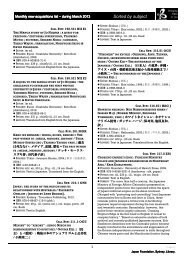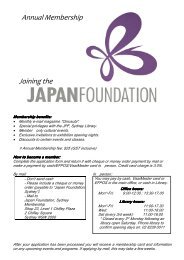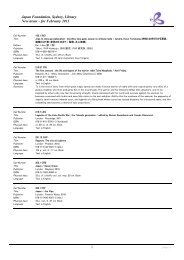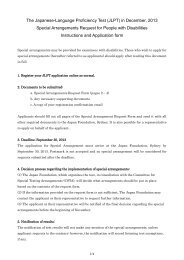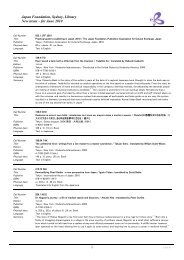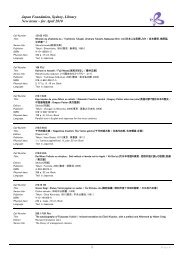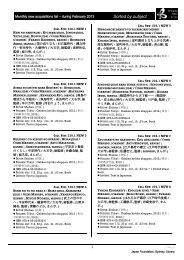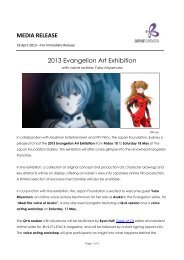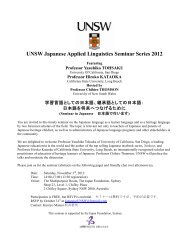Video Recording collection - The Japan Foundation
Video Recording collection - The Japan Foundation
Video Recording collection - The Japan Foundation
You also want an ePaper? Increase the reach of your titles
YUMPU automatically turns print PDFs into web optimized ePapers that Google loves.
<strong>Japan</strong> <strong>Foundation</strong>, Sydney, Library<br />
<strong>Video</strong> catalogue (VHS, DVD) – Indexed by call number<br />
System requirements:VHS (NTSC).<br />
Language: Soundtrack chiefly in <strong>Japan</strong>ese.<br />
Summary: This is a recording of the performance Kusa Meikyu by<br />
performance group Papa Tarahumara.<br />
Call Number: 769.1 HAK<br />
Title: Introduction to <strong>Japan</strong>ese classical dance = Nihon buyo<br />
[videorecording]<br />
Publisher: Sydney : Hakusen School 1999<br />
Physical description: <strong>Video</strong> <strong>Recording</strong> 1 videocassette<br />
System requirements: VHS [PAL]<br />
Language: Soundtrack in English.<br />
Call Number: 769.1 NIS<br />
Title: Mochizuki no koma, Ningen damono, Izumi no hime : dai 53<br />
kai Nagoya odori [videorecording]<br />
Publisher: [Tokyo] : [Tokyo Nishikawa-kai] 2000<br />
Physical description: 166 min <strong>Video</strong> <strong>Recording</strong><br />
System requirements:VHS (NTSC).<br />
Language: Soundtrack in <strong>Japan</strong>ese.<br />
Call Number: 769.1 NIS<br />
Title: Nagoya odori shokai bideo = [<strong>Japan</strong>ese style dance introduction<br />
video performed by Nishikawa-ryu] [videorecording]<br />
Publisher: [Nagoya] : [Nishikawa-ryu] 2001<br />
Physical description: 19min <strong>Video</strong> <strong>Recording</strong><br />
System requirements:VHS (NTSC).<br />
Language: Soundtrack in <strong>Japan</strong>ese.<br />
Call Number: 769.1 NIS 22<br />
Title: Dai 22-kai Nishikawa Senzō risaitaru = Senzo Nishikawa the<br />
22th recital / M Entāpuraizu seisaku. [videorecording]| 第 22 回 西 川<br />
扇 藏 リサイタル = Senzo Nishikawa the 22th recital / M エンタープ<br />
ライズ 制 作 .|<br />
Publisher: [S.l.] : [Nishikawaryū], [2005].<br />
Physical description: 1 videodisc (DVD, NTSC, Region 2) (90 min.) :sd.,<br />
col. ;4 3/4 in.+ 1 booklet (8 p., 18 cm.) <strong>Video</strong> <strong>Recording</strong><br />
System requirements: VHS [PAL]<br />
Call Number: 769.1 YOK<br />
Title: Miracle - Chin Kham Yoke [videorecording]<br />
Publisher: [Sydney, NSW : Chin Kham Yoke] 1996<br />
Physical description: 60 min <strong>Video</strong> <strong>Recording</strong><br />
System requirements: VHS [PAL]<br />
Summary: A recording of a live performance at the "Performance Space"<br />
Sydney on the 3/11/1996.<br />
Call Number: 769.1 YOK<br />
Title: <strong>The</strong> Other Shadow - Dance By Chin Kham Yoke<br />
[videorecording]<br />
Publisher: [Sydney : Chin Kham Yoke] 1994<br />
Physical description: 25 min <strong>Video</strong> <strong>Recording</strong><br />
System requirements: VHS [PAL]<br />
Call Number: 772.1 EDO<br />
Title: <strong>The</strong> Edo Stage - Kabuki and Bunraku [videorecording]<br />
Publisher: Tokyo : Kokusai Koryu Kikin = <strong>The</strong> <strong>Japan</strong> <strong>Foundation</strong> 1989<br />
Physical description: 29min <strong>Video</strong> <strong>Recording</strong><br />
System requirements: VHS [PAL]<br />
Language: Soundtrack chiefly in English.<br />
Summary: "Kabuki became extremely popular in Edo in the latter half of<br />
the 18th century. It was a reflection of an era in which the audience could<br />
view a dramatized version of their lives on stage. Both Kabuki and<br />
Bunraku were a social satire, which appealed to all classes and ages. This<br />
documentary looks at Ebiso, a modern performer from a 12th generation<br />
family of Kabuki performers. He still regularly appears in Kabuki in<br />
Asakusa and one of his more famous characters is portrayed and<br />
explained in this dicumentary. Chikamatsu Monzaemon was a very<br />
famous <strong>Japan</strong>ese writer whom had some of his literature adapted to<br />
Bunraku(puppet theater). A popular piece Sonezaki Shinju about lover<br />
features at the end of this documenatry." -- FROM CONTAINER.<br />
Call Number: 773 JPF<br />
Title: Noh <strong>The</strong>atre - Embassy of <strong>Japan</strong> [videorecording]<br />
Publisher: [Canberra, ACT : <strong>The</strong> Embassy of <strong>Japan</strong>] 1995<br />
Physical description: 110 min <strong>Video</strong> <strong>Recording</strong><br />
System requirements: VHS [PAL]<br />
Summary: A live of a Noh performance given at the Ambassadors<br />
residence in Canberra, attended by the Prince and Princess Akishino.<br />
Contents of evening; * Official Entrance of Guests, * Tea Ceremony by<br />
Urasenke <strong>Foundation</strong>, * <strong>The</strong> Stone Brodge and <strong>The</strong> Ground Spider, Noh<br />
Performances<br />
Call Number: 773 NHK<br />
Title: Noh drama (NHK International video library (Traditional<br />
<strong>Japan</strong>ese culture = Nihon no dento bunka ; 3)) [videorecording]<br />
Publisher: Tokyo : NHK International<br />
Physical description: 20min <strong>Video</strong> <strong>Recording</strong><br />
System requirements: VHS [PAL]<br />
Language: Soundtrack in English.<br />
Summary: "Noh Drama is one of <strong>Japan</strong>'s great theatrical traditions. With<br />
its history of 600 years, Noh is the world's oldest continuous tradition of<br />
poetic drama. Within the older modes of poetry, singing and dancing, the<br />
vasy compass of human emotions is given expression, snd is elevated to<br />
the sphere of fine art. By introducing some famous plays, the program<br />
shows how the realm of human passion is embodied in the mask,<br />
movement, and music of Noh and preserved for all time on the stage". --<br />
FROM CONTAINER.<br />
Restriction & Screening notes: Not for Loan. Licensed for public<br />
screening at JF-Sydney<br />
Call Number: 773 NOH<br />
Title: No nyumon = Introduction to <strong>Japan</strong>ese Noh (Set of 2 video<br />
tapes ; No towa donna monoka = This is Noh ; No ""Izutsu"" = Noh<br />
""Izutsu"" - <strong>The</strong> wooden water well) [videorecording]<br />
Publisher: Kyoto : Noh <strong>The</strong>atre Association, Kyoto Branch. Kyoto Noh<br />
Association 2000<br />
Physical description: 40 min x 2 <strong>Video</strong> <strong>Recording</strong><br />
System requirements: VHS [PAL]<br />
Language: Soundtrack in English.<br />
Summary: "Scripted by Noh actors by themselves, this video presents<br />
portions of numerous plays, rehearsals, and individual dances to provide<br />
deep insight into the art of noh <strong>Japan</strong>'s profoundlly moving ancient<br />
masked dance-drama". -- FROM CONTEINAR.<br />
Call Number: 773.28 JAM 9<br />
Title: 650 years at center stage = Otoko no harebutai : 650 nen no<br />
dento o mau [videorecording]<br />
Publisher: Tokyo : <strong>Japan</strong> Media Communication Center = JAMCO 1998<br />
Physical description: 49 min <strong>Video</strong> <strong>Recording</strong><br />
System requirements: VHS [PAL]<br />
Language: Soundtrack in English.<br />
Summary: "Kimitake Ueda has been performing Noh for 31 of his 34<br />
years, and recently passes a milestone with his rendition of the bell<br />
sequence in the Dojoji Temple play. This episode follows the<br />
determinding life of a Noh actor, focusing on Ueda, the third of four sons<br />
born to a Noh master of the Kanze School of Kobe, as he undertakes a<br />
seven0year apprenticeship program. <strong>The</strong> world of Noh theater is very<br />
diciplined, and an aspiring actor most sharpen all his sence and absorb the<br />
36 1-Apr-09



